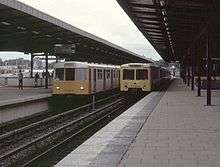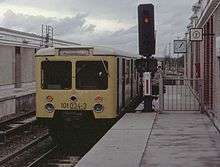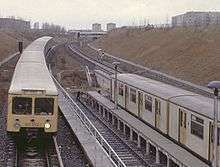BVG Class E
In East Berlin, the vehicle situation was poor. Because the C-trains had been transported to Moscow in 1945, there were no Großprofil trains left for the Line E. So, just like in the beginning years of the Großprofil, Kleinprofil vehicles with boards attached to the sides were used. These trains had the designation AI K. 40 trains were being re-deployed to the Line E after the war. These "Blumenbratter" trains were also deployed on Line D on the Workers' Uprising and the Berlin strike in 1953.
Therefore, BVG had to commission an E-type for Berlin U-Bahn after temporarily reassigning the Kleinprofil trains with boards. So far only the EI and EIII trains were built. Most of the trains were converted from DR Class ET 165, DR Class ET 168 and DR Class ET 169, as they were originally from certain critical parts of the Berlin S-Bahn.
EI trains
In 1958, the VEB Waggonbau Ammendorf built two prototypes of the new EI train. Because it was made of steel its weight was enormous, and it would have required too great an amount of energy to be used regularly. No production models of those trains were built.
EII trains
Plans for an EII type train were dropped in 1962 because of political problems. Finally, those responsible in the GDR ministry of transport had the idea of converting S-Bahn trains, which had become surplus because of the boycott of the S-Bahn in the west.
EIII trains
Batch 1


| Number (bef 1970) |
Number (aft 1970) |
Number (aft 1992) |
Dispensed Trains |
|---|---|---|---|
| 1410/1411 | 101 002/151 003 | 1802/1803 | ET 168 009/EB 168 009 |
| 1412/1413 | 101 004/151 005 | 1804/1805 | ET 168 022/EB 168 002 |
| 1414/1415 | 101 006/151 007 | 1806/1807 | ET 168 037/EB 168 037 |
| 1416/1417 | 101 008/151 009 | 1808/1809 | ET 168 036/EB 168 036 |
| 1418/1419 | 101 010/151 011 | 1810/1811 | ET 168 031/EB 168 031 |
| 1420/1421 | 101 012/151 013 | 1812/1813 | ET 168 042/EB 168 029 |
| 1422/1423 | 101 014/151 015 | 1814/1815 | ET 168 046/EB 168 042 |
| 1424/1425 | 101 016/151 017 | 1816/1817 | ET 168 028/EB 168 028 |
| 1426/1427 | 101 018/151 019 | 1818/1819 | ET 168 018/EB 168 018 |
| 1428/1429 | 101 020/151 021 | 1820/1821 | ET 168 019/EB 168 019 |
| 1430/1431 | 101 022/151 023 | 1822/1823 | ET 168 040/EB 168 040 |
| 1432/1433 | 101 024/151 025 | 1824/1825 | ET 168 047/EB 168 047 |
| 1434/1435 | 101 026/151 027 | 1826/1827 | ET 168 044/EB 168 044 |
| 1436/1437 | 101 028/151 029 | 1828/1829 | ET 168 024/EB 168 024 |
| 1438/1439 | 101 030/151 031 | 1830/1831 | ET 168 020/EB 168 020 |
| 1440/1441 | 101 032/151 033 | 1832/1833 | ET 168 007/EB 168 012 |
| 1442/1443 | 101 034/151 035 | 1834/1835 | ET 168 001/EB 168 001 |
| 1444/1445 | 101 036/151 037 | 1836/1837 | ET 168 017/EB 168 017 |
| 1446/1447 | 101 038/151 039 | 1838/1839 | ET 168 021/EB 168 021 |
| 1448/1449 | 101 040/151 041 | 1840/1841 | ET 165 419/EB 165 419 |
| 1450/1451 | 101 042/151 043 | 1842/1843 | ET 165 038/EB 165 038 |
| 1452/1453 | 101 044/151 045 | 1844/1845 | ET 165 037/EB 165 037 |
The project began in the summer of 1962. Six trains of the S-Bahn type 168 were converted in the Reichsbahnausbesserungswerk Schöneweide (RAW) until the end of 1962. All in all, five batches of this new U-Bahn train type, called EIII, were delivered.
Batch 2
| Number (bef 1970) |
Number (aft 1970) |
Number (aft 1992) |
Dispensed Trains |
|---|---|---|---|
| 1454/1455 | 102 050/152 051 | 1850/1851 | ET 169 031a |
| 1456/1457 | 102 052/152 053 | 1852/1853 | ET 169 013b |
| 1458/1459 | 102 054/152 055 | 1854/1855 | ET 169 010a |
| 1460/1461 | 102 056/152 057 | 1856/1857 | ET 169 010b |
| 1462/1463 | 102 058/152 059 | 1858/1859 | ET 169 008a |
| 1464/1465 | 102 060/152 061 | 1860/1861 | ET 169 008b |
| 1466/1467 | 102 062/152 063 | 1862/1863 | ET 169 002a |
| 1468/1469 | 102 064/152 065 | 1864/1865 | ET 169 002b |
| 1470/1471 | 102 066/152 067 | 1866/1867 | ET 169 006a |
| 1472/1473 | 102 068/152 069 | 1868/1869 | ET 169 006b |
| 1474/1475 | 102 070/152 071 | 1870/1871 | ET 169 016a |
| 1476/1477 | 102 072/152 073 | 1872/1873 | ET 169 016b |
| 1478/1479 | 102 074/152 075 | 1874/1875 | ET 169 015a |
| 1480/1481 | 102 076/152 077 | 1876/1877 | ET 169 015b |
The Kleinprofil trains could finally be moved back from the E line to the A line, which sorely needed the trains due to a very large number of passengers on the segment between Schönhauser Allee and Alexanderplatz.
The fleet numbering system was changed from 14xx to 10x (Triebwagen) and 15x (Beiwagen) series for the trains.
Batch 3

| Number (aft 1970) |
Number (aft 1992) |
Dispensed Trains |
|---|---|---|
| 103 080/153 081 | 1880/1881 | 275 837/275 838 |
| 103 082/153 083 | 1882/1883 | 275 839/275 840 |
| 103 084/153 085 | 1884/1885 | 275 849/275 850 |
| 103 086/153 087 | 1886/1887 | 275 835/275 836 |
Construction began for the extension of Line E from Friedrichsfelde to Tierpark, to serve the Tierpark Zoo there. In order to increase the capacity for the extension, BVB had to get 4 trains from the DR Class 275. These trains were converted between 9 September 1972 and 25 January 1973.
Batch 4
| Number (bis 1970) |
Number (ab 1970) |
Dispensed Trains |
|---|---|---|
| 104 090/154 091 | 1890/1891 | 275 671/275 672 |
| 104 092/154 093 | 1892/1893 | 275 759/275 760 |
| 104 094/154 095 | 1894/1895 | 275 217/275 218 |
| 104 096/154 097 | 1896/1897 | 275 795/275 796 |
| 104 097/154 099 | 1898/1899 | 275 823/275 824 |
After the opening of Tierpark station, there was a need to increase capacity on the Line E. Therefore, BVB had to convert five more trains which is from the DR Clsas 275. These trains were delivered between 1975 and 1982.
Batch 5
| Number (bef 1992) |
Number (aft 1992) |
Dispensed Trains |
|---|---|---|
| 105 100/155 101 | 1900/1901 | 275 613/275 614 |
| 105 102/155 103 | 1902/1903 | 275 035/275 036 |
| 105 104/155 105 | 1904/1905 | 275 077/275 406 |
| 105 106/155 107 | 1906/1907 | 275 445/275 446 |
| 105 108/155 109 | 1908/1909 | 275 229/275 230 |
| 105 110/155 111 | 1910/1911 | 275 549/275 550 |
| 105 112/155 113 | 1912/1913 | 275 957/275 670 |
| 105 114/155 115 | 1914/1915 | 275 197/275 198 |
| 105 116/155 117 | 1916/1917 | 275 827/275 372 |
| 105 118/155 119 | 1918/1919 | 275 497/275 498 |
| 105 120/155 121 | 1920/1921 | 275 329/275 330 |
| 105 122/155 123 | 1922/1923 | 275 821/275 960 |
| 105 124/155 125 | 1924/1925 | 275 321/275 322 |
| 105 126/155 127 | 1926/1927 | 275 139/275 140 |
| 105 128/155 129 | 1928/1929 | 275 359/275 360 |
| 105 130/155 131 | 1930/1931 | 275 607/275 820 |
| 105 132/155 133 | 1932/1933 | 275 065/275 066 |
| 105 134/155 135 | 1934/1935 | 275 657/275 448 |
| 105 136/155 137 | 1936/1937 | 275 731/275 554 |
| 105 138/155 139 | 1938/1939 | 275 829/275 830 |
| 105 140/155 141 | 1940/1941 | 275 079/275 080 |
| 105 142/155 143 | 1942/1943 | 275 145/275 146 |
| 105 144/155 145 | 1944/1945 | 275 159/275 160 |
| 105 146/155 147 | 1946/1947 | 275 463/275 464 |
| 105 148/155 149 | 1948/1949 | 275 089/275 090 |
| 105 150/155 151 | 1950/1951 | 275 101/275 102 |
| 105 152/155 153 | 1952/1953 | 275 123/275 124 |
| 105 154/155 155 | 1954/1955 | 275 207/275 208 |
| 105 156/155 157 | 1956/1957 | 275 055/275 056 |
| 105 158/155 159 | 1958/1959 | 275 523/275 524 |
| 105 160/155 161 | 1960/1961 | 275 211/275 212 |
| 105 162/155 163 | 1962/1963 | 275 825/275 826 |
| 105 164/155 165 | 1964/1965 | 275 029/275 030 |
| 105 166/155 167 | 1966/1967 | 275 789/275 790 |
| 105 168/155 169 | 1968/1969 | 275 259/275 260 |
| 105 170/155 171 | 1970/1971 | 275 447/275 553 |
| 105 172/155 173 | 1972/1973 | 275 017/275 018 |
| 105 174/155 175 | 1974/1975 | 275 367/275 368 |
| 105 176/155 177 | 1976/1977 | 275 409/275 410 |
| 105 178/155 179 | 1978/1979 | 275 349/275 350 |
| 105 180/155 181 | 1980/1981 | 277 293/275 644 |
BVB had the need to order new trains because of the extension of Line E from Tierpark to the Hellersdorf area and Hönow. BVB had contracted several trains from the Berlin S-Bahn and those selected D57/D60 units from the BVG which was originally destined to be scrapped. The first two prototypes started delivery in May 1986 before the subsequent delivery in September 1986. The condition was later reversed. For safety reasons, the ceilings of the manufacturer plate was given after the trains were burnt out at Klosterstraße station. 25 double-end cars were also added into the fleet for the D class trains, whereas the remainder of 41 were Line E. The last of these trains were delivered before September 1990, just before Die Wende.
EIV trains
The GDR or the BVB planned already further: Although it has developed 50 since the mid-years useful subway trains, but the technique of these traits came mostly from S-Bahn trains, which were built in the 1920s and the 1930s, and thus very was old, where it was cleared by the BVB. On the other hand, enormous efforts have been made by the industry to develop a modern S-Bahn train. This then succeeded so well with the series 270 (now 485), which were produced in the years 1987-92 for the German Reichsbahn in series (model already arisen in 1979/80). In LEW in Hennigsdorf since the 80s there were already filed for a new subway train for large profile line E as the successor to the E-III trains. They had dimensioned the timeframe so that the mid-90s should be started with the delivery of this thoroughly modern trains. You should get an AC drive, among other things, what would have been a novelty for local trains in the GDR. Design studies for this new type of train has never existed since the turn of 1989/90 the works were set on this type of train.
After reunification
In 1992, when the BVB was re-unified with the BVG (West) to form BVG, the trains were progressively renumbered from 10x and 15x series, into the 18xx and 19xx. Most of the trains were also serviced in the Wannsee depot in the meantime before transferring to the reunified Deutsche Bahn on 1 January 1994. The management board of the BVG decided to replace the EIII cars into a new millennium with the new F cars.
This allowed phasing out of the trains to target those beyond EIII.4 cars. According to some sources, some trains will be sold to Warsaw Metro after the retirement, but it did not materialise. This would also be a modernisation of the trains such that trains will have BOStrab. The vehicles had received no major studies, the last unit 1818/1819 left on 11 January 1993 from the Raw in this state.
Originally the BVG wanted to keep the EIII trains until 1999, but because of enormous operating and maintenance costs after the reunification of Germany, the EIII trains were retired as early as 1994. There were plans to use up the EIII/4 of the lifespan until 1995, and the EIII/5 and EIII/5U until 2000. Since the necessary spare vehicles for the Class F were not ready, the BVG proceeded to redeploy more trains to the U8 and reduce the number of trains of U5, until the H class trains were delivered.
The trains were not designed for use in magnetically secured routes. Some of the aspects include relatively sedate driving techniques. There have been attempts to test the EIII trains on other lines, however this was failed. The actual last day is on 16 July 1994. The last trains were 1830/1831+1810/1811+1842/1843 and 1916/1917+1914/1915+1908/1909, running from Alexanderplatz to Hönow.
References
- ↑ Biedl and Walter 2001, p. 32.
- ↑ Biedl and Walter 2001, p. 41.
- ↑ Biedl and Walter 2001, p. 48.
- ↑ Biedl and Walter 2001, pp. 64–65.
- Biedl, Andreas; Walter, Norbert (2001). Die Fahrzeuge der Berliner U-Bahn. Typ E (in German). Berlin: VBN Verlag Bernd Neddermeyer. ISBN 3-933254-17-5.